name: inverse layout: true class: center, middle, inverse <div class="my-header"><span> <a href="/training-material/topics/statistics" title="Return to topic page" ><i class="fa fa-level-up" aria-hidden="true"></i></a> <a href="https://github.com/galaxyproject/training-material/edit/main/topics/statistics/tutorials/FNN/slides.html"><i class="fa fa-pencil" aria-hidden="true"></i></a> </span></div> <div class="my-footer"><span> <img src="/training-material/assets/images/GTN-60px.png" alt="Galaxy Training Network" style="height: 40px;"/> </span></div> --- <img src="/training-material/assets/images/GTNLogo1000.png" alt="Galaxy Training Network" class="cover-logo"/> <br/> <br/> # Feedforward neural networks (FNN) Deep Learning - Part 1 <br/> <br/> <div markdown="0"> <div class="contributors-line"> <ul class="text-list"> <li> <a href="/training-material/hall-of-fame/kxk302/" class="contributor-badge contributor-kxk302"><img src="https://avatars.githubusercontent.com/kxk302?s=36" alt="Kaivan Kamali avatar" width="36" class="avatar" /> Kaivan Kamali</a></li> </ul> </div> </div> <!-- modified date --> <div class="footnote" style="bottom: 8em;"> <i class="far fa-calendar" aria-hidden="true"></i><span class="visually-hidden">last_modification</span> Updated: <i class="fas fa-fingerprint" aria-hidden="true"></i><span class="visually-hidden">purl</span><abbr title="Persistent URL">PURL</abbr>: <a href="https://gxy.io/GTN:S00089">gxy.io/GTN:S00089</a> </div> <!-- other slide formats (video and plain-text) --> <div class="footnote" style="bottom: 5em;"> <i class="fas fa-file-alt" aria-hidden="true"></i><span class="visually-hidden">text-document</span><a href="slides-plain.html"> Plain-text slides</a> | </div> <!-- usage tips --> <div class="footnote" style="bottom: 2em;"> <strong>Tip: </strong>press <kbd>P</kbd> to view the presenter notes | <i class="fa fa-arrows" aria-hidden="true"></i><span class="visually-hidden">arrow-keys</span> Use arrow keys to move between slides </div> ??? Presenter notes contain extra information which might be useful if you intend to use these slides for teaching. Press `P` again to switch presenter notes off Press `C` to create a new window where the same presentation will be displayed. This window is linked to the main window. Changing slides on one will cause the slide to change on the other. Useful when presenting. --- ## Requirements Before diving into this slide deck, we recommend you to have a look at: - [Statistics and machine learning](/training-material/topics/statistics) - Introduction to deep learning: [<i class="fas fa-laptop" aria-hidden="true"></i><span class="visually-hidden">tutorial</span> hands-on](/training-material/topics/statistics/tutorials/intro_deep_learning/tutorial.html) --- ### <i class="far fa-question-circle" aria-hidden="true"></i><span class="visually-hidden">question</span> Questions - What is a feedforward neural network (FNN)? - What are some applications of FNN? --- ### <i class="fas fa-bullseye" aria-hidden="true"></i><span class="visually-hidden">objectives</span> Objectives - Understand the inspiration for neural networks - Learn activation functions & various problems solved by neural networks - Discuss various loss/cost functions and backpropagation algorithm - Learn how to create a neural network using Galaxy’s deep learning tools - Solve a sample regression problem via FNN in Galaxy --- # What is an artificial neural network? ??? What is an artificial neural network? --- # Artificial Neural Networks - ML discipline roughly inspired by how neurons in a human brain work - Huge resurgence due to availability of data and computing capacity - Various types of neural networks (Feedforward, Recurrent, Convolutional) - FNN applied to classification, clustering, regression, and association --- # Inspiration for neural networks - Neuron a special biological cell with information processing ability - Receives signals from other neurons through its *dendrites* - If the signals received exceeds a threshold, the neuron fires - Transmits signals to other neurons via its *axon* - *Synapse*: contact between axon of a neuron and denderite of another - Synapse either enhances/inhibits the signal that passes through it - Learning occurs by changing the effectiveness of synapse 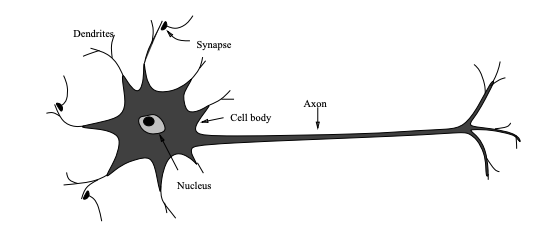 <!-- https://pixy.org/3013900/ CC0 license--> --- # Celebral cortex - Outter most layer of brain, 2 to 3 mm thick, surface area of 2,200 sq. cm - Has about 10^11 neurons - Each neuron connected to 10^3 to 10^4 neurons - Human brain has 10^14 to 10^15 connections --- # Celebral cortex - Neurons communicate by signals ms in duration - Signal transmission frequency up to several hundred Hertz - Millions of times slower than an electronic circuit - Complex tasks like face recognition done within a few hundred ms - Computation involved cannot take more than 100 serial steps - The information sent from one neuron to another is very small - Critical information not transmitted - But captured by the interconnections - Distributed computation/representation of the brain - Allows slow computing elements to perform complex tasks quickly --- # Perceptron 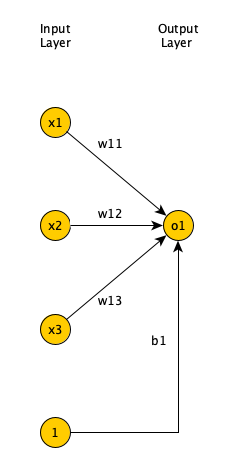 <!-- https://pixy.org/3013900/ CC0 license--> --- # Learning in Perceptron - Given a set of input-output pairs (called *training set*) - Learning algorithm iteratively adjusts model parameters - Weights and biases - So the model can accurately map inputs to outputs - Perceptron learning algorithm --- # Limitations of Perceptron - Single layer FNN cannot solve problems in which data is not linearly separable - E.g., the XOR problem - Adding one (or more) hidden layers enables FNN to represent any function - *Universal Approximation Theorem* - Perceptron learning algorithm could not extend to multi-layer FNN - AI winter - *Backpropagation* algorithm in 80's enabled learning in multi-layer FNN --- # Multi-layer FNN 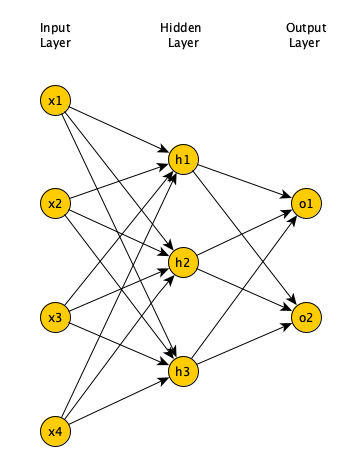 <!-- https://pixy.org/3013900/ CC0 license--> - More hidden layers (and more neurons in each hidden layer) - Can estimate more complex functions - More parameters increases training time - More likelihood of *overfitting* --- # Activation functions  <!-- https://pixy.org/3013900/ CC0 license--> --- # Supervised learning - Training set of size *m*: { (x^1,y^1),(x^2,y^2),...,(x^m,y^m) } - Each pair (x^i,y^i) is called a *training example* - x^i is called *feature vector* - Each element of feature vector is called a *feature* - Each x^i corresponds to a *label* y^i - We assume an unknown function y=f(x) maps feature vectors to labels - The goal is to use the training set to learn or estimate f - We want the estimate to be close to f(x) not only for training set - But for training examples not in training set --- # Classification problems 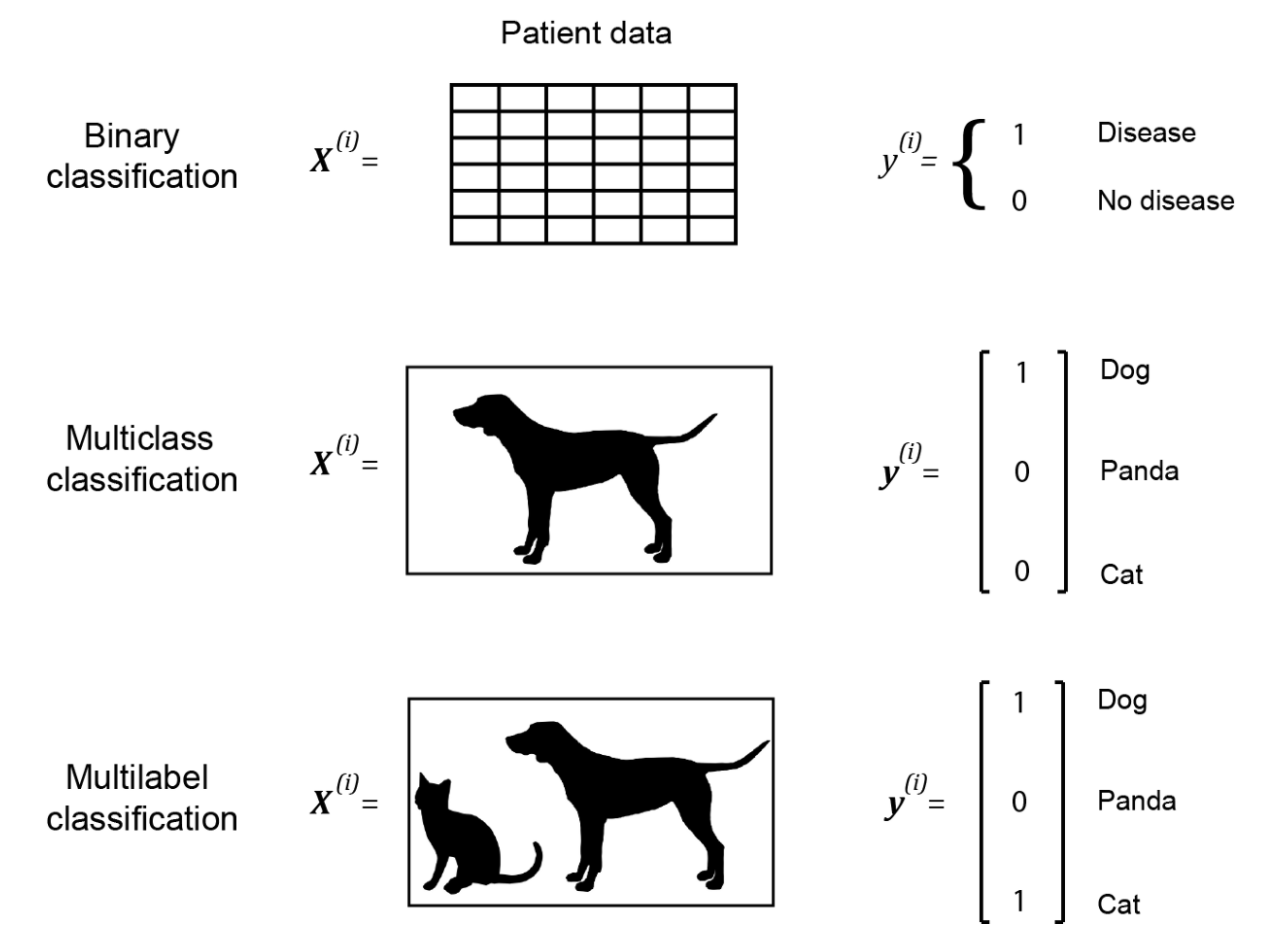 <!-- https://pixy.org/3013900/ CC0 license--> --- # Output layer - Binary classification - Single neuron in output layer - Sigmoid activation function - Activation > 0.5, output 1 - Activation <= 0.5, output 0 - Multilabel classification - As many neurons in output layer as number of classes - Sigmoid activation function - Activation > 0.5, output 1 - Activation <= 0.5, output 0 --- # Output layer (Continued) - Multiclass classification - As many neurons in output layer as number of classes - *Softmax* activation function - Takes input to neurons in output layer - Creates a probability distribution, sum of outputs adds up to 1 - The neuron with the highest proability is the predicted label - Regression problem - Single neuron in output layer - Linear activation function --- # Loss/Cost functions - During training, for each training example (x^i,y^i), we present x^i to neural network - Compare predicted output with label y^1 - Need loss function to measure difference between predicted & expected output - Use *Cross entropy* loss function for classification problems - And *Quadratic* loss function for regression problems - Quadratic cost function is also called *Mean Squared Error (MSE)* --- # Cross Entropy Loss/Cost functions  <!-- https://pixy.org/3013900/ CC0 license-->  <!-- https://pixy.org/3013900/ CC0 license--> --- # Quadratic Loss/Cost functions  <!-- https://pixy.org/3013900/ CC0 license-->  <!-- https://pixy.org/3013900/ CC0 license--> --- # Backpropagation (BP) learning algorithm - A *gradient descent* technique - Find local minimum of a function by iteratively moving in opposite direction of gradient of function at current point - Goal of learning is to minimize cost function given training set - Cost function is a function of network weights & biases of all neurons in all layers - Backpropagation iteratively computes gradient of cost function relative to each weight and bias - Updates weights and biases in the opposite direction of gradient - Gradients (partial derivatives) are used to update weights and biases - To find a local minimum --- # Backpropagation error  <!-- https://pixy.org/3013900/ CC0 license--> --- # Backpropagation formulas  <!-- https://pixy.org/3013900/ CC0 license--> --- # Types of Gradient Descent - *Batch* gradient descent - Calculate gradient for each weight/bias for *all* samples - Average gradients and update weights/biases - Slow, if we have too many samples - *Stochastic* gradient descent - Update weights/biases based on gradient of *each* sample - Fast. Not accurate if sample gradient not representiative - *Mini-batch* gradient descent - Middle ground solution - Calculate gradient for each weight/bias for all samples in *batch* - batch size is much smaller than training set size - Average batch gradients and update weights/biases --- # Vanishing gradient problem - Second BP equation is recursive - We have derivative of activation function - Calc. error in layer prior to output: 1 mult. by derivative value - Calc. error in two layers prior output: 2 mult. by derivative values - If derivative values are small (e.g. for Sigmoid), product of multiple small values will be a very small value - Since error values decide updates for biases/weights - Update to biases/weights in first layers will be very small - Slowing the learning algorithm to a halt - The reason Sigmoid not used in deep networks - Why ReLU is popular in deep networks --- # Car purchase price prediction - Given 5 features of an individual (age, gender, miles driven per day, personal debt, and monthly income) - And, money they spent buying a car - Learn a FNN to predict how much someone will spend buying a car - We evaluate FNN on test dataset and plot graphs to assess the model’s performance - Training dataset has 723 training examples - Test dataset has 242 test examples - Input features scaled to be in 0 to 1 range --- # For references, please see tutorial's References section --- - Galaxy Training Materials ([training.galaxyproject.org](https://training.galaxyproject.org)) 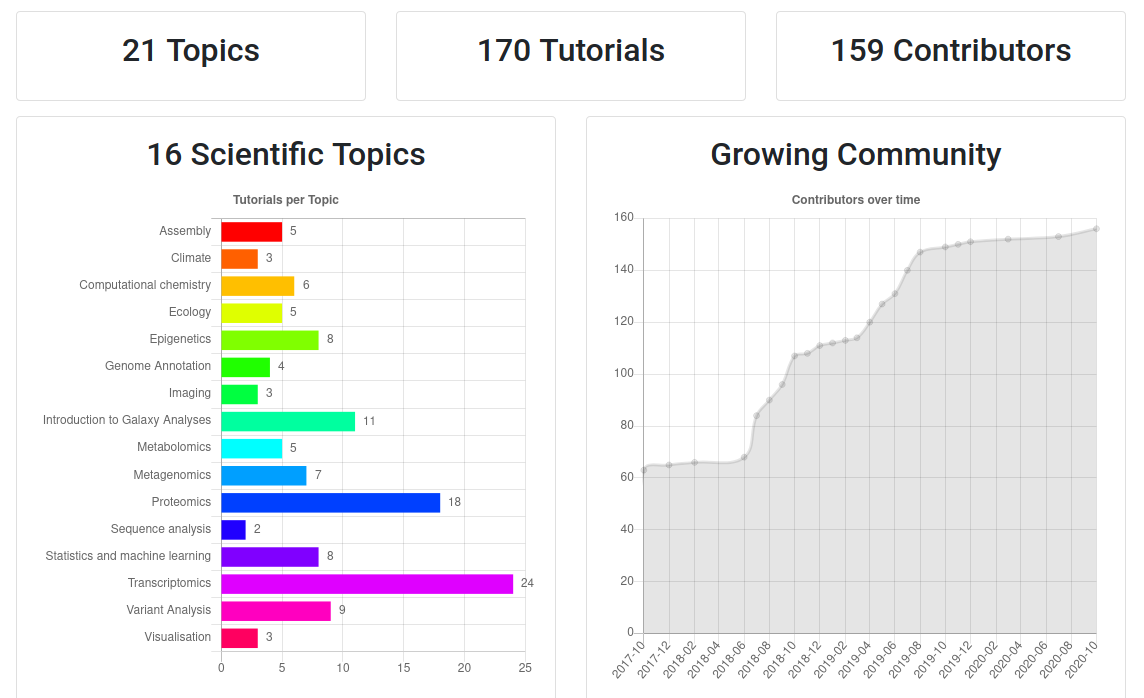 ??? - If you would like to learn more about Galaxy, there are a large number of tutorials available. - These tutorials cover a wide range of scientific domains. --- # Getting Help - **Help Forum** ([help.galaxyproject.org](https://help.galaxyproject.org))  - **Gitter Chat** - [Main Chat](https://gitter.im/galaxyproject/Lobby) - [Galaxy Training Chat](https://gitter.im/Galaxy-Training-Network/Lobby) - Many more channels (scientific domains, developers, admins) ??? - If you get stuck, there are ways to get help. - You can ask your questions on the help forum. - Or you can chat with the community on Gitter. --- # Join an event - Many Galaxy events across the globe - Event Horizon: [galaxyproject.org/events](https://galaxyproject.org/events) 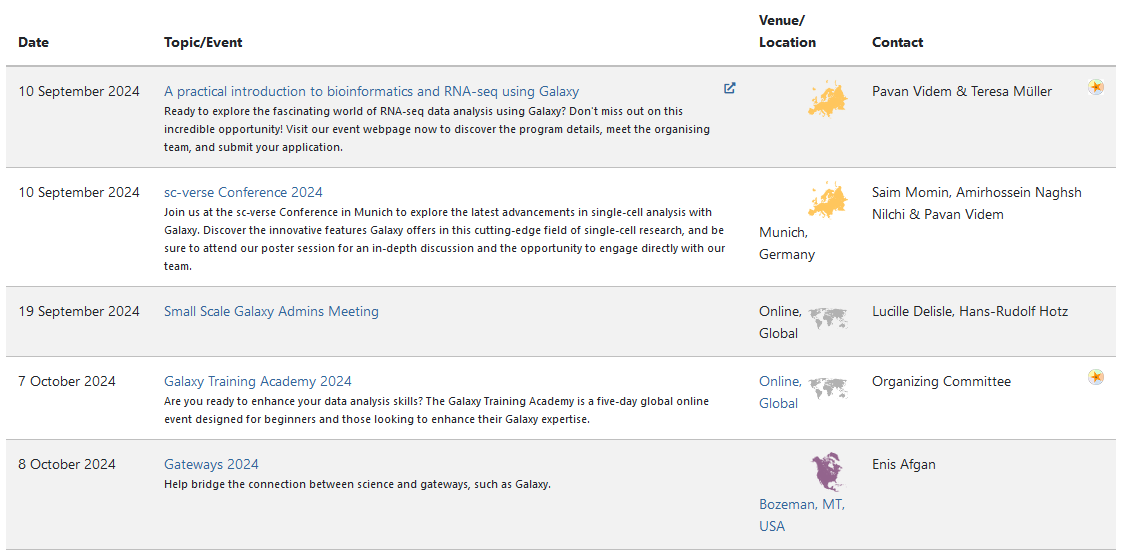 ??? - There are frequent Galaxy events all around the world. - You can find upcoming events on the Galaxy Event Horizon. --- ## Thank You! This material is the result of a collaborative work. Thanks to the [Galaxy Training Network](https://training.galaxyproject.org) and all the contributors! <div markdown="0"> <div class="contributors-line"> <table class="contributions"> <tr> <td><abbr title="These people wrote the bulk of the tutorial, they may have done the analysis, built the workflow, and wrote the text themselves.">Author(s)</abbr></td> <td> <a href="/training-material/hall-of-fame/kxk302/" class="contributor-badge contributor-kxk302"><img src="https://avatars.githubusercontent.com/kxk302?s=36" alt="Kaivan Kamali avatar" width="36" class="avatar" /> Kaivan Kamali</a> </td> </tr> <tr class="reviewers"> <td><abbr title="These people reviewed this material for accuracy and correctness">Reviewers</abbr></td> <td> <a href="/training-material/hall-of-fame/anuprulez/" class="contributor-badge contributor-badge-small contributor-anuprulez"><img src="https://avatars.githubusercontent.com/anuprulez?s=36" alt="Anup Kumar avatar" width="36" class="avatar" /></a><a href="/training-material/hall-of-fame/kxk302/" class="contributor-badge contributor-badge-small contributor-kxk302"><img src="https://avatars.githubusercontent.com/kxk302?s=36" alt="Kaivan Kamali avatar" width="36" class="avatar" /></a><a href="/training-material/hall-of-fame/hexylena/" class="contributor-badge contributor-badge-small contributor-hexylena"><img src="https://avatars.githubusercontent.com/hexylena?s=36" alt="Helena Rasche avatar" width="36" class="avatar" /></a><a href="/training-material/hall-of-fame/gallardoalba/" class="contributor-badge contributor-badge-small contributor-gallardoalba"><img src="https://avatars.githubusercontent.com/gallardoalba?s=36" alt="Cristóbal Gallardo avatar" width="36" class="avatar" /></a><a href="/training-material/hall-of-fame/shiltemann/" class="contributor-badge contributor-badge-small contributor-shiltemann"><img src="https://avatars.githubusercontent.com/shiltemann?s=36" alt="Saskia Hiltemann avatar" width="36" class="avatar" /></a></td> </tr> </table> </div> </div> <div style="display: flex;flex-direction: row;align-items: center;justify-content: center;"> <img src="/training-material/assets/images/GTNLogo1000.png" alt="Galaxy Training Network" style="height: 100px;"/> </div> Tutorial Content is licensed under <a rel="license" href="http://creativecommons.org/licenses/by/4.0/">Creative Commons Attribution 4.0 International License</a>.<br/>